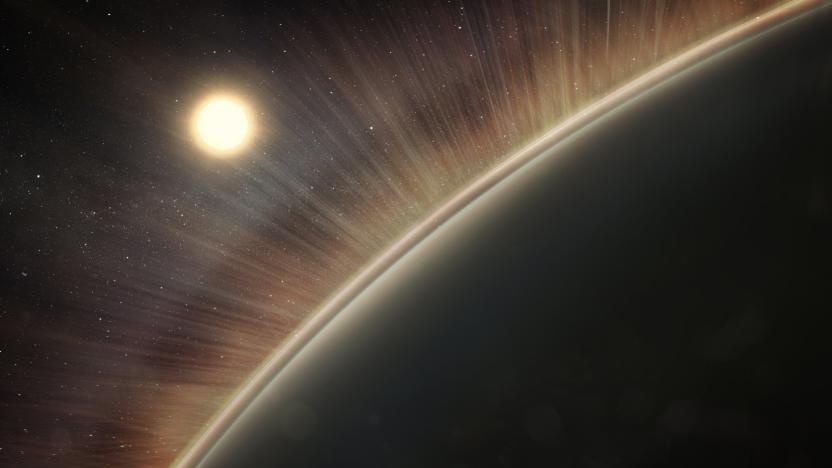electricity
Latest

MIT's sensor network tracks your power-hungry appliances
You get a bill from your electricity provider every month laying out how much energy you used, but there's no easy way to get a breakdown of which appliances suck down the most juice. But the US Navy has partnered with MIT scientists to design a cheap, portable sensor network that tracks the power drain of each of your domestic devices.

A totally new energy source in slow moving rivers
try{document.getElementById("aol-cms-player-1").style.display="none";}catch(e){}Today on In Case You Missed It: University of Michigan researchers spent years creating a water-harnessing river turbine to create electricity, called the VIVACE. It's the first time electricity appears to be effectively generated in slower rivers rather than oceans, but that's because the developers used physics to get turning turbines to agitate the water enough to create more energy for their neighboring cylinders. It's an as-yet prototype but a promising new development in the realm of water-powered electricity. If you're interested in the giant balloon video from China, that's here, and the JibJab app can be downloaded from an app store. As always, please share any interesting tech or science videos you find by using the #ICYMI hashtag on Twitter for @mskerryd.

Audiophiles in Japan are installing their own electricity poles
Audiophiles are known for doing some pretty extreme things in their quest for 'purer' sound, such as buying headphones that cost as much as a good car or getting ridiculously overdone cables with little to no practical benefit. However, the Wall Street Journal notes that some Japanese listeners are taking things one step further. When Takeo Morita worried that "tainted" power would affect the quality of his tunes, he installed a roughly $10,000 utility pole with his own transformer to get more electricity straight from the grid. And he's not alone -- there's a whole magazine dedicated just to selling audio-related power equipment, including poles.

Google used DeepMind AI to cut its power bill
Google's grand experiment in using artificial intelligence to save power is paying off. The search firm's Demis Hassabis tells Bloomberg that the DeepMind AI has cut electricity use at Google data centers by "several percentage points" thanks to its extra-efficient use of equipment, such as cooling systems and windows. It's not certain just how much energy the smart code is saving, but Google used slightly over 4.4 gigawatt-hours in 2014 alone -- even a small dent in that consumption could easily save hundreds of millions of dollars. That pricey DeepMind acquisition is likely paying for itself.

Mandalay Bay installs America's biggest solar roof
The Mandalay Bay Convention Center in Las Vegas, NV is now home to the largest roof-top solar array in America. The array consists of 26,000 individual panels and produces enough power to meet roughly 25 percent of the convention center's energy requirements. The two other largest casinos along the strip, presumably The Venetian and the Wynn, have also reportedly installed solar panels in efforts to reduce their electricity bills. The state of Nevada as a whole has set an ambitious goal of producing a quarter of its electricity from clean sources by 2025. That's no small feat given that the Bellagio and Mandalay Bay alone consume more electricity annually than all of Key West, FL, a city with a population of 25,000 but which hosts roughly 2.5 million visitors each year.

Venus' electric wind stripped its atmosphere of water
Venus is even less forgiving than scientists thought. NASA researchers have discovered that the planet has an electrical field so massive (five times larger than Earth's) that it creates a wind strong enough to strip the atmosphere of water. It's a one-two punch: the sunlight breaks the water down into hydrogen and oxygen ions, while the electric wind speeds up those ions to the point that they can escape Venus' gravity. NASA isn't certain why the field is so large, but they suspect that Venus' proximity to the Sun (and the resulting bright ultraviolet light) might play a role.

Artificial 'leaf' could beat real plants at converting sunlight
Natural photosynthesis is considered a good target for solar energy conversion, but it's already considered old hat. Harvard scientists have developed a leaf-like system that should be more effective at converting solar energy than plants themselves. The technology boils down to a jar of bacteria (Ralstonia eutropha), a cobalt water-splitting system and a pair of electrodes. When you send electricity through this partly biological system, the electrodes turn the water into hydrogen gas that you can use for fuel and carbon-based materials. It's only 10 percent efficient, but that's better than the widely established 8 percent baseline for real-world performance.

Dining with the electric fork that could save lives
This prototype fork can help you eat less salt and could save lives. It sends a gentle electric current to your tongue as you eat, fooling tastebuds into experiencing a salty, (sometimes sour) taste -- even when there's little to no salt in the food itself. Despite the awkward notion of willingly putting an electric current into your mouth, the "electro-fork" can potentially tackle some legitimate health issues. According to the World Health Organization, we consume 10 grams of salt a day -- double the amount it recommends. This increases one's chances of hypertension, heart disease, strokes and more. So, in the interest of my health (and morbid curiosity), I went for a taste test.

China eyes floating nuclear power plants for remote locations
It's difficult to provide power to offshore projects like oil rigs and a recently built island chain in the South China Sea. However, China has a solution: floating nuclear power plants. According to the state-run newspaper Global Times, the vessels are being developed with the goal of providing electricity to offshore construction projects, even in remote locations. China Shipbuilding Industry Corporation, a state-run company, is working to build an entire fleet of the floating power plants citing strong demand for the ships.

Mechanical 'trees' generate energy by swaying in the wind
What if windmills looked more like trees? Well, a team of engineers at Ohio State University is looking for answer to that question with structures that resemble trees, but actually create energy when they move in the breeze. That swaying motion from the wind, and the resulting structural vibrations, is converted into electricity with electromechanical materials such as polyvinylidene fluoride (PVDF). The project isn't merely concerned with those tree-like structures, though. It also looks to harvest the energy generated from the vibrations of buildings and bridges.

Tesla batteries will help power California office buildings
Tesla is about to prove that its energy storage batteries aren't just meant for saving money (and possibly, the environment) at home. The Irvine Company plans to outfit office buildings across California with Tesla battery farms that, in an initial phase, will both reduce electricity demand at peak hours and give Southern California Edison up to 10 megawatts of reserve power. That's enough to light up 10,000 homes, folks. Up to 24 buildings in Irvine will get the upgrade in this first wave, and there are hints of more in the long run.

Clean energy is nearly as inexpensive as coal and gas
One of the biggest obstacles to adopting solar or wind power is simply the cost of getting started. However much an electricity company might save in the long run, that up-front expense is tough to swallow. Or rather, it was -- Bloomberg New Energy Finance study has found that the cost of clean energy has dropped so much that it's within spitting distance of dirty sources like coal and gas. The global average cost of onshore wind power has dipped to $83 per megawatt-hour, while silicon solar power now costs $122. Neither of those figures is trivial, but they're not much different than what firms pay for coal (which has risen to $75 per MWh in the Americas) or gas turbines ($82 per MWh). Some green tech is still expensive, such as offshore wind ($174) and marine ($400-plus), but prices have fallen there, too.

Japan to restart nuclear power tomorrow after energy prices soar
It's been four years since an earthquake and tsunami knocked out the nuclear reactor at Fukushima, causing a meltdown and mass evacuation of the local area. The tragedy eventually saw the shut down of all of the nation's nuclear power plants, with the last facilities closing down in late 2013. This week, the country is going to start one of them back up: tomorrow, Japan will switch on reactor No.1 at the Sendai nuclear power plant.

IBM wants to cool data centers with their own waste heat
Those "do not eat" desiccate packets of silica gel that keep shoe boxes dry could soon help keep data centers cool. IBM has launched the THRIVE project with aims to do just that by creating a heat pump that runs on waste heat.

Batteries that stretch are perfect for smart watches and clothes
Used to be that the only time your lithium-ion batteries changed their shape was when they were about to explode in an airliner cargo hold. But thanks to the ingenuity of an Arizona State University research team, future power packs could not only bend but stretch up to 150 percent of their original size while providing an uninterrupted stream of power. Their secret: the ancient Japanese art form of Kirigami. It's an offshoot of the more well-known Origami form that involves both folding and cutting the working material.

Americans are using more energy, but green tech is softening the blow
It may be tough to satisfy the US' seemingly never-ending thirst for energy, but clean power sources are at least helping to soften the impact. Researchers at the Lawrence Livermore National Laboratory have determined that Americans' energy use climbed 1 percent year-over-year in 2014, but its carbon emissions hardly budged at all. In fact, they were down significantly for coal and petroleum-based power. While some of that decline is due to industry using less-than-clean natural gas, it's also helped by big jumps in solar and wind energy, which respectively grew by 33 and 8 percent.

Nikola Labs' case uses stray radio waves to charge your iPhone
To hear Nikola Labs co-founder Dr. Rob Lee tell the tale, some 97 percent of the energy a smartphone expends to forge data and voice connections using radio frequencies is lost to the ether. Rather than let it all go to waste, this Ohio-based startup claims to have cooked up a way to harness that power and redirect it using a a humble-looking, $99 iPhone case. Unlike more involved solutions like the ultrasound power transmission system that uBeam has raised over $13 million to help build, there aren't any transmitters you need to stand in range of. The end result? A case that silently, slowly captures your iPhone's wasted power and uses it for recharging.

Tesla will reveal a battery for your home at its April event
You don't have to wonder any longer as to what Tesla will unveil at its April 30th event -- the company just spoiled things in advance. In an email to investors, the company states that its shindig will reveal both a previously-teased battery for your home and a "very large," utility-oriented battery. Details aren't forthcoming (those are for the big show!), but there's a good chance that the hardware will build on the concepts behind existing home batteries, which are often used to store excess solar power and provide backups during outages. The real questions are whether or not Tesla can improve on personal powerplants like it did electric cars, and how much you'll pay versus the competition. You'll likely get the answers to both riddles in just over a week.

Britain's new electricity 'T-pylons' carry power with style
Electricity pylons might be a vital part of the UK's power infrastructure, but they sure ain't the prettiest of things, especially when towering over otherwise unspoiled countryside. Their design hasn't changed in nearly a century, but soon you could start seeing a new, much sleeker type of pylon dotting the landscape. Winner of a 2011 competition seeking fresh and more attractive designs, the "T-pylon" is a far cry from our familiar steel lattice structures, with a lone trunk sprouting two arms that support power cables in a diamond arrangement. Ahead of going into formal use, the construction of the first T-pylon test site is now underway at the National Grid's training academy in rural Nottinghamshire. They're not designed to replace what we have already, but will serve as another option in areas where its looks and smaller footprint "can offer real advantages."

Goodyear's working on an energy-harvesting tire
It's a fundamental principle of physics that when you use energy, say to run an electric car, some of it is lost. Companies have tried to overcome this by installing hardware that harvests this lost heat, most famously in regenerative braking. Goodyear is hoping to do a similar thing with tyres, dreaming up a product that could, theoretically, convert the heat generated from the friction of movement back into power for the battery.









